
Pennsylvania Avenue is a diagonal street in Washington, D.C., and Prince George's County, Maryland, that connects the White House and the United States Capitol and then crosses the city to Maryland. In Maryland it is also Maryland Route 4 to MD 717 in Upper Marlboro, where it becomes Stephanie Roper Highway. The section between the White House and Congress is called "America's Main Street"; it is the location of official parades and processions, as well as protest marches. Moreover, Pennsylvania Avenue is an important commuter road and is part of the National Highway System.
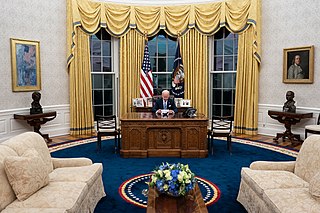
The Oval Office is the formal working space of the President of the United States. Part of the Executive Office of the President of the United States, it is located in the West Wing of the White House, in Washington, D.C.

The Washington Navy Yard (WNY) is the former shipyard and ordnance plant of the United States Navy in Southeast Washington, D.C. It is the oldest shore establishment of the U.S. Navy.
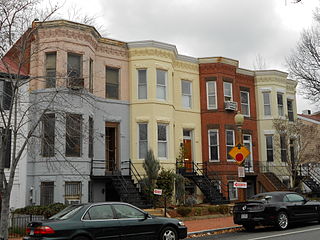
Capitol Hill, in addition to being a metonym for the United States Congress, is the largest historic residential neighborhood in Washington, D.C., stretching easterly in front of the United States Capitol along wide avenues. It is one of the oldest residential neighborhoods in Washington, D.C., and, with roughly 35,000 people in just under 2 square miles (5 km2), it is also one of the most densely populated.

Southeast is the southeastern quadrant of Washington, D.C., the capital of the United States, and is located south of East Capitol Street and east of South Capitol Street. It includes the Capitol Hill and Anacostia neighborhoods, the Navy Yard, the Joint Base Anacostia-Bolling (JBAB), the U.S. Marine Barracks, the Anacostia River waterfront, Eastern Market, the remains of several Civil War-era forts, historic St. Elizabeths Hospital, RFK Stadium, Nationals Park, and the Congressional Cemetery. It also contains a landmark known as "The Big Chair," located on Martin Luther King Jr. Avenue. The quadrant is split by the Anacostia River, with the portion that is west of the river sometimes referred to as "Near Southeast". Geographically, it is the second-smallest quadrant of the city.
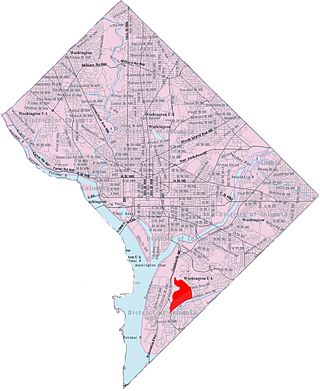
Congress Heights is a residential neighborhood in Southeast Washington, D.C., in the United States. The irregularly shaped neighborhood is bounded by the St. Elizabeths Hospital campus, Lebaum Street SE, 4th Street SE, and Newcomb Street SE on the northeast; Shepard Parkway and South Capitol Street on the west; Atlantic Street SE and 1st Street SE on the south; Oxon Run Parkway on the southeast; and Wheeler Street SE and Alabama Avenue SE on the east. Commercial development is heavy along Martin Luther King, Jr. Avenue and Malcolm X Avenue.

Ronald Harold Nessen is an American government official who served as the 15th White House Press Secretary for President Gerald Ford from 1974 to 1977. He replaced Jerald terHorst, who resigned in the wake of President Ford's pardon of former president Richard Nixon.

The Eisenhower Executive Office Building (EEOB)—formerly known as the Old Executive Office Building (OEOB), and originally as the State, War, and Navy Building—is a U.S. government building situated just west of the White House in the U.S. capital of Washington, D.C. Maintained by the General Services Administration, it is currently occupied by the Executive Office of the President, including the Office of the Vice President of the United States. In 1999, it was named for former president and general Dwight D. Eisenhower.
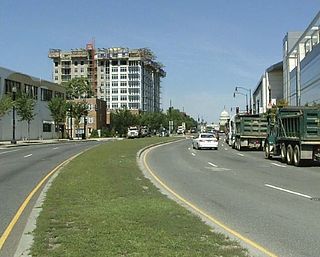
South Capitol Street is a major street dividing the southeast and southwest quadrants of Washington, D.C., in the United States. It runs south from the United States Capitol to the D.C.–Maryland line, intersecting with Southern Avenue. After it enters Maryland, the street becomes Indian Head Highway at the Eastover Shopping Center, a terminal or transfer point of many bus routes.
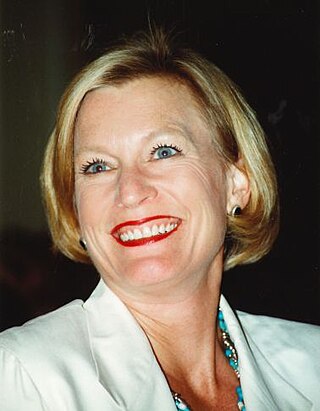
Susan Elizabeth Ford Bales is an American author, photojournalist, and former chair of the board of the Betty Ford Center for alcohol and drug abuse. She is the daughter of Gerald Ford, the 38th president of the United States and his wife Betty Ford née Bloomer.

Navy Yard, also known as Near Southeast, is a neighborhood on the Anacostia River in Southeast Washington, D.C. Navy Yard is bounded by Interstate 695 to the north and east, South Capitol Street to the west, and the Anacostia River to the south. Approximately half of its area is occupied by the Washington Navy Yard, which gives the neighborhood its name. The neighborhood is located in D.C.'s Ward 6, currently represented by Charles Allen. It is served by the Navy Yard – Ballpark Metro station on the Green Line.

Greenway is a residential neighborhood in Southeast Washington, D.C., in the United States. The neighborhood is bounded by East Capitol Street to the north, Pennsylvania Avenue SE to the south, Interstate 295 to the west, and Minnesota Avenue to the east.
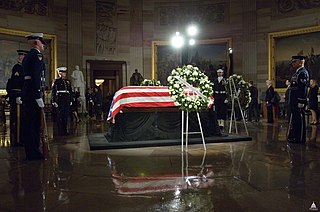
On December 26, 2006, Gerald Ford, the 38th president of the United States, died at his home in Rancho Mirage, California at 6:45 p.m. local time. At 8:49 p.m. local time, President Ford's wife of 58 years, Betty Ford, issued a statement that confirmed his death: "My family joins me in sharing the difficult news that Gerald Ford, our beloved husband, father, grandfather and great-grandfather has passed away at 93 years of age. His life was filled with love of God, his family and his country." The causes of death listed on the subsequent death certificate were arteriosclerotic cerebrovascular disease and diffuse arteriosclerosis.
USS Anacostia was a steamer, constructed as a tugboat, that was first chartered by the United States Navy for service during the Paraguay crisis of the 1850s and then commissioned as a U.S. Navy ship. She later served prominently in the Union Navy during the American Civil War.
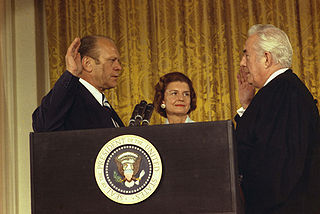
The inauguration of Gerald Ford as the 38th president of the United States was held on Friday, August 9, 1974, in the East Room of the White House in Washington, D.C., after President Richard Nixon resigned due to the Watergate scandal. The inauguration – the last non-scheduled, extraordinary inauguration to take place in the 20th century – marked the commencement of Gerald Ford's only term as president. Chief Justice Warren E. Burger administered the oath of office. The Bible upon which Ford recited the oath was held by his wife, Betty Ford, open to Proverbs 3:5–6. Ford was the ninth vice president to succeed to the presidency intra-term, and he remains the most recent to do so, as of 2023.
The Capitol Riverfront is a business improvement district (BID) located just south of the United States Capitol between Capitol Hill and the Anacostia River in Washington, D.C. It was created by the District of Columbia City Council and approved by Mayor Fenty in August 2007. The BID is a mixed-use neighborhood. It was a former industrial area transformed into a business center, urban neighborhood, entertainment district, and waterfront destination. The project involves adding over 9,000 new apartments, condominiums, lofts, modern office towers, 1,200 hotel rooms, one million square feet of retail amenities, two grocery stores, new restaurants, shops, and cafes. Over 33,900,000 square feet of office, residential, hotel, and retail space, as well as four new parks, were planned over 10–15 years. The new 5-acre (20,000 m2) riverfront Yards Park opened in fall 2010.

The Yards is a 42-acre (17 ha) development on the Anacostia River waterfront in Washington, D.C. The area is at the center of the Capitol Riverfront Business Improvement District and was originally an annex of the Washington Navy Yard. In 2004, the U.S. General Services Administration awarded the property to Forest City Washington, Inc. for redevelopment into an area with 2,800 new residential units and 2,200,000 sq ft (200,000 m2) of office and retail space. The development is just west of the Washington Navy Yard and east of Nationals Park. It is served by the Navy Yard – Ballpark station on the Green Line of the Washington Metro.
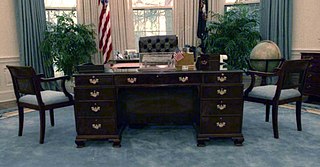
The C&O desk is one of only six desks ever used in the Oval Office by a sitting President of the United States. The C&O Desk was used there only by George H. W. Bush, one of two Oval Office desks to be used by only one president. Prior to its use in the Oval Office by Bush, the desk had been used elsewhere in the White House. It is the shortest-served Oval Office desk to date, having been used for only one four-year term.

The White House's art collection, sometimes also called the White House Collection or Pride of the American Nation, has grown over time from donations from descendants of the Founding Fathers to commissions by established artists. It comprises paintings, sculptures, and other art forms. At times, the collection grows from a president's specific request, such as when Ronald Reagan began collecting the work of naval artist Tom Freeman in 1986, a tradition that continued through the Obama years.


















